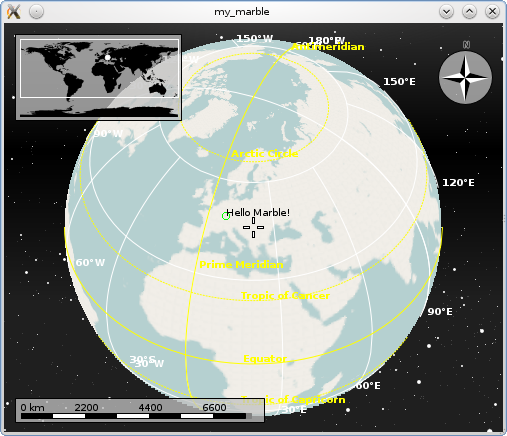Marble/MarbleGeoPainter
| Tutorial Series | Marble C++ Tutorial |
| Previous | Tutorial 12 - Opening .kml, .gpx... files |
| What's Next | Tutorial 14 - Drawing in Custom Layers |
| Further Reading | n/a |
In the previous tutorial you've seen how easy it is to embed a MarbleWidget into a Qt application: Just create a MarbleWidget, set a map theme on it and ... you're done already.
Next we'll extend that example a bit and write our own little paint method to add some extra content to the globe. To facilitate this, Marble provides a painting hook called MarbleWidget::customPaint. It is called in between of the normal paint operations: After the background and tiles are painted, but before the top layers like float items (info boxes).
The customPaint operation is called with a GeoPainter: An extended QPainter which not only is able to paint at certain screen (pixel) positions, but also at certain geo (lat,lon) positions. We'll make use of that feature now. To keep things simple again, we just add a little 'Hello World' message indicated by a green circle.
#include <QtGui/QApplication>
#include <marble/MarbleWidget.h>
#include <marble/GeoPainter.h>
using namespace Marble;
class MyMarbleWidget : public MarbleWidget
{
public:
virtual void customPaint(GeoPainter* painter);
};
void MyMarbleWidget::customPaint(GeoPainter* painter)
{
GeoDataCoordinates home(8.4, 49.0, 0.0, GeoDataCoordinates::Degree);
painter->setPen(Qt::green);
painter->drawEllipse(home, 7, 7);
painter->setPen(Qt::black);
painter->drawText(home, "Hello Marble!");
}
int main(int argc, char** argv)
{
QApplication app(argc,argv);
MyMarbleWidget *mapWidget = new MyMarbleWidget;
mapWidget->setMapThemeId("earth/openstreetmap/openstreetmap.dgml");
mapWidget->show();
return app.exec();
}
Save the code above as my_marble.cpp and compile it:
g++ -I /usr/include/qt4/ -o my_marble my_marble.cpp -lmarblewidget -lQtGui
If things go fine, execute ./my_marble and you end up with a globe view similar to this:
There may be situations where MarbleWidget::customPaint() does not suit your needs. This can be the case when you don't want to paint at the very top position (above all other items), or when subclassing MarbleWidget is not possible for some reason. In that case, have a look at the next chapter Drawing in Custom Layers
The latest source code of this example can be found here.

